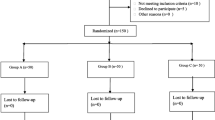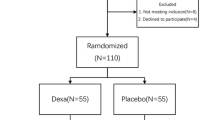Abstract
Purpose
To study the clinical effect and safety of two doses of low-dose perioperative dexamethasone on pain and recovery after total knee arthroplasty.
Methods A total of 108 patients were included in this randomized, double-blinded, placebo-controlled study. They received two doses of 10 mg IV dexamethasone (group Dexa) or IV isotonic saline (group Placebo). The CRP, IL-6 and pain levels, postoperative nausea and vomiting (PONV) incidence, nausea severity, postoperative fatigue, range of motion, length of stay, analgesic rescue and antiemetic rescue consumption, and complications were compared.
Results The CRP and IL-6 levels in group Dexa were lower than in group Placebo at 24, 48, and 72 h postoperatively (P < 0.001, P < 0.001, and P < 0.001, respectively). In group Dexa, patients had less pain at 24 h postoperatively, at rest (P < 0.001) and during walking (P < 0.001); they also had a lower PONV incidence (P = 0.002) and a lower nausea VAS score (P = 0.008). Postoperative fatigue (P < 0.001) was relieved and the analgesic and antiemetic rescue consumption was reduced. Length of stay (n.s.) and range of motion (n.s.) were similar in both groups. No early surgical wound infection or gastrointestinal haemorrhage occurred in either group.
Conclusions Administering two doses of low-dose perioperative dexamethasone for patients receiving total knee arthroplasty reduces postoperative CRP and IL-6 levels, provides additional analgesic effect, and reduces the PONV incidence and postoperative fatigue, without increasing the risk of early surgical wound infection and gastrointestinal haemorrhage. So two doses of low-dose perioperative dexamethasone are effective and safe for patients receiving TKA to decrease the inflammatory response, prevent PONV, relieve postoperative pain and fatigue, and enhance recovery.
Level of evidence I.



Similar content being viewed by others
Change history
19 June 2017
An erratum to this article has been published.
References
Backes JR, Bentley JC, Politi JR, Chambers BT (2013) Dexamethasone reduces length of hospitalization and improves postoperative pain and nausea after total joint arthroplasty: a prospective, randomized controlled trial. J Arthroplast 28(8 Suppl):11–17
Bautmans I, Njemini R, De Backer J, De Waele E, Mets T (2010) Surgery-induced inflammation in relation to age, muscle endurance, and self-perceived fatigue. J Gerontol A Biol Sci Med Sci 65(3):266–273
Bautmans I, Njemini R, Lambert M, Demanet C, Mets T (2005) Circulating acute phase mediators and skeletal muscle performance in hospitalized geriatric patients. J Gerontol A Biol Sci Med Sci 60(3):361–367
Bird SB, Dickson EW (2001) Clinically significant changes in pain along the visual analog scale. Ann Emerg Med 38(6):639–643
Bisgaard T, Klarskov B, Kehlet H, Rosenberg J (2003) Preoperative dexamethasone improves surgical outcome after laparoscopic cholecystectomy: a randomized double-blind placebo-controlled trial. Ann Surg 238(5):651–660
De Oliveira GS Jr, Almeida MD, Benzon HT, McCarthy RJ (2011) Perioperative single dose systemic dexamethasone for postoperative pain: a meta-analysis of randomized controlled trials. Anesthesiology 115(3):575–588
Fujii Y, Nakayama M (2005) Effects of dexamethasone in preventing postoperative emetic symptoms after total knee replacement surgery: a prospective, randomized, double-blind, vehicle-controlled trial in adult Japanese patients. Clin Ther 27(6):740–745
Gilron I (2004) Corticosteroids in postoperative pain management: future research directions for a multifaceted therapy. Acta Anaesthesiol Scand 48(10):1221–1222
Holte K, Kehlet H (2002) Perioperative single-dose glucocorticoid administration: pathophysiologic effects and clinical implications. J Am Coll Surg 195(5):694–712
Husted H, Jensen CM, Solgaard S, Kehlet H (2012) Reduced length of stay following hip and knee arthroplasty in Denmark 2000–2009: from research to implementation. Arch Orthop Trauma Surg 132(1):101–104
Jensen MP, Chen C, Brugger AM (2003) Interpretation of visual analog scale ratings and change scores: a reanalysis of two clinical trials of postoperative pain. J Pain 4(7):407–414
Jules-Elysee KM, Lipnitsky JY, Patel N et al (2011) Use of low-dose steroids in decreasing cytokine release during bilateral total knee replacement. Reg Anesth Pain Med 36(1):36–40
Kehlet H, Jensen TS, Woolf CJ (2006) Persistent postsurgical pain: risk factors and prevention. The Lancet 367(9522):1618–1625
Kehlet H, Wilmore DW (2002) Multimodal strategies to improve surgical outcome. Am J Surg 183(6):630–641
Koh IJ, Chang CB, Lee JH, Jeon YT, Kim TK (2013) Preemptive low-dose dexamethasone reduces postoperative emesis and pain after TKA: a randomized controlled study. Clin Orthop Relat Res 471(9):3010–3020
Liberati A, Altman DG, Tetzlaff J et al (2009) The PRISMA statement for reporting systematic reviews and meta-analyses of studies that evaluate healthcare interventions: explanation and elaboration. BMJ 339:b2700
Lunn TH, Kehlet H (2013) Perioperative glucocorticoids in hip and knee surgery - benefit vs. harm? A review of randomized clinical trials. Acta Anaesthesiol Scand 57(7):823–834
Lunn TH, Kristensen BB, Andersen LO et al (2011) Effect of high-dose preoperative methylprednisolone on pain and recovery after total knee arthroplasty: a randomized, placebo-controlled trial. Br J Anaesth 106(2):230–238
Miyagawa Y, Ejiri M, Kuzuya T, Osada T, Ishiguro N, Yamada K (2010) Methylprednisolone reduces postoperative nausea in total knee and hip arthroplasty. J Clin Pharm Ther 35(6):679–684
Paddison JS, Booth RJ, Fuchs D, Hill AG (2008) Peritoneal inflammation and fatigue experiences following colorectal surgery: a pilot study. Psychoneuroendocrinology 33(4):446–454
Paddison JS, Booth RJ, Hill AG, Cameron LD (2006) Comprehensive assessment of peri-operative fatigue: development of the Identity-Consequence Fatigue Scale. J Psychosom Res 60(6):615–622
Romundstad L, Breivik H, Roald H et al (2006) Methylprednisolone reduces pain, emesis, and fatigue after breast augmentation surgery: a single-dose, randomized, parallel-group study with methylprednisolone 125 mg, parecoxib 40 mg, and placebo. Anesth Analg 102(2):418–425
Salerno A, Hermann R (2006) Efficacy and safety of steroid use for postoperative pain relief. Update and review of the medical literature. J Bone Joint Surg Am 88(6):1361–1372
Sean VW, Chin PL, Chia SL, Yang KY, Lo NN, Yeo SJ (2011) Single-dose periarticular steroid infiltration for pain management in total knee arthroplasty: a prospective, double-blind, randomised controlled trial. Singapore Med J 52(1):19–23
Wehner S, Vilz TO, Stoffels B, Kalff JC (2012) Immune mediators of postoperative ileus. Langenbecks Arch Surg 397(4):591–601
Wilmore DW, Kehlet H (2001) Management of patients in fast track surgery. BMJ 322(7284):473–476
Xie J, Ma J, Yao H, Yue C, Pei F (2016) Multiple boluses of intravenous tranexamic acid to reduce hidden blood loss After primary total knee arthroplasty without tourniquet: a randomized clinical trial. J Arthroplast 31(11):2458–2464
Zargar-Shoshtari K, Paddison JS, Booth RJ, Hill AG (2009) A prospective study on the influence of a fast-track program on postoperative fatigue and functional recovery after major colonic surgery. J Surg Res 154(2):330–335
Zhang JM, An J (2007) Cytokines, inflammation, and pain. Int Anesthesiol Clin 45(2):27–37
Acknowledgements
The study was supported by Ministry of Health of the People’s Republic of China (201302007).
Author information
Authors and Affiliations
Corresponding author
Ethics declarations
Conflict of interest
All authors declare that they have no conflict of interest.
Ethical approval
The study protocol was approved by the Institutional Review Board of West China Medical Center of Sichuan University (No. 201302007) before patient enrolment.
Funding
This study was funded by Ministry of Health of the People’s Republic of China (no. 201302007).
Informed consent
Written informed consent and research authorization were obtained from all patients.
Additional information
The original version of this article was revised: Unfortunately, the online published article has error in Table 2. In the Metoclopramide, Number of patients requiring, The P value should be 0.018.
Xu and Ma have contributed equally to this study.
Rights and permissions
About this article
Cite this article
Xu, B., Ma, J., Huang, Q. et al. Two doses of low-dose perioperative dexamethasone improve the clinical outcome after total knee arthroplasty: a randomized controlled study. Knee Surg Sports Traumatol Arthrosc 26, 1549–1556 (2018). https://doi.org/10.1007/s00167-017-4506-x
Received:
Accepted:
Published:
Issue Date:
DOI: https://doi.org/10.1007/s00167-017-4506-x




